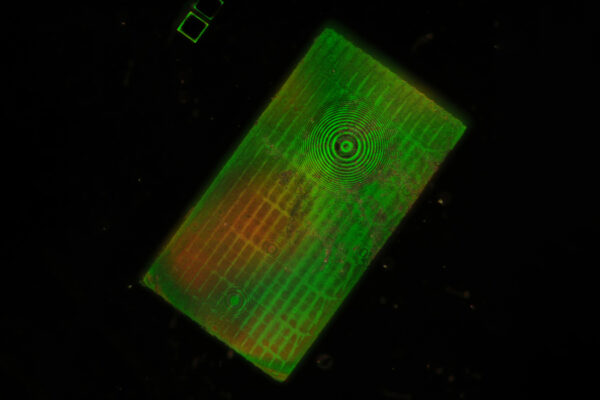
Metamaterial creates flat fisheye lens
For the fisheye lens, the team at MIT and the University of Massachusetts at Lowell used a thin glass sheet etched with nanostructures that scatter incoming light to produce panoramic images. The lens works in the infrared part of the spectrum, but the researchers say it could be modified to capture images using visible light as well.
The design could be used in smartphones and laptops as well as medical imaging devices such as endoscopes, as well as in virtual reality glasses, wearable electronics, and other computer vision devices.
“This design comes as somewhat of a surprise, because some have thought it would be impossible to make a metalens with an ultra-wide-field view,” said Juejun Hu, associate professor in MIT’s Department of Materials Science and Engineering. “The fact that this can actually realize fisheye images is completely outside expectation.”
The metalens is a single transparent piece made from calcium fluoride with a thin film of lead telluride deposited on one side. The team then used lithographic techniques to etch the optical structures into the film that operate with 5.2micron IR light.
Each structure is shaped into one of several nanoscale geometries, such as a rectangular or a bone-shaped configuration, to produce a phase delay.
In conventional fisheye lenses, the curvature of the glass naturally creates a distribution of phase delays that ultimately produces a panoramic image. The team determined the corresponding pattern of meta-atoms and carved this pattern into the back side of the flat glass.
Next: Metamaterial fisheye lens design
‘We’ve designed the back side structures in such a way that each part can produce a perfect focus,” said Hu.
To make a similar flat fisheye lens for visible light the optical features may have to be made smaller than they are now, to better refract that particular range of wavelengths. The lens material would also have to change. But the general architecture that the team has designed would remain the same.
The researchers are looking at other applications such as panoramic projectors, as well as depth sensors built directly into smartphones, laptops, and wearable devices.
“Currently, all 3D sensors have a limited field of view, which is why when you put your face away from your smartphone, it won’t recognize you,” said Guys. “What we have here is a new 3D sensor that enables panoramic depth profiling, which could be useful for consumer electronic devices.”
This research was funded in part by US defence agency DARPA under the EXTREME Program.
Related articles
- ACOUSTIC METAMATERIAL CAN FOCUS SOUND LIKE A LENS
- CNT-BASED METAMATERIAL TURNS HEAT INTO LIGHT
- METAMATERIAL STARTUP RAISES FUNDS TO IMPROVE AUTOMOTIVE RADAR
- STARTUP RAISES FUNDING FOR 3D-PRINTED AUTOMOTIVE ANTENNA AND RADAR TECHNOLOGY
Other articles on eeNews Europe
- Digital microbubble array creates ultrasound holograms
- Production starts for 20s Covid-19 test
- IBM aims for million qubit quantum computer
- Battery tech and 5G at heart of European Covid-19 recovery
 If you enjoyed this article, you will like the following ones: don't miss them by subscribing to :
eeNews on Google News
If you enjoyed this article, you will like the following ones: don't miss them by subscribing to :
eeNews on Google News


